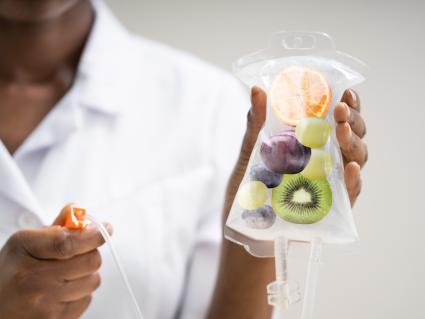Tips to Encourage Healthy Nutrition in Children with Special Needs

Disclaimer: nutrition can be extremely varied, I am touching on the general aspects to building the foundation of nutritional health in special needs children from personal experience. Please feel free to take what works and leave what preferences or changes do not fit your beliefs, lifestyles, or allergies.
###
As it pertains to childhood health, there are several avenues that may be considered to compose the overall framework of health. The child’s nutrition in regards to quality food and water, daily physical activity, and adequate sleep are the basic foundation of their daily functioning. Another influence to health is the environment in which the child is living and exposed too; and having this environment conducive to stimulating their creativity, imagination, and learning. One should also consider the child’s emotional support including love, security and sense of acceptance. I would also add the importance of inspiring spirituality or a connection to something greater than themselves. There are more arenas that can influence health, but the above are the basics to feed their body, mind, spirit, and soul. If there is an alteration in the functioning of the child’s physical, mental, or emotional ability the ways we meet these needs may require more creativity and support. I would even argue that for these beautiful individuals the need for those things mentioned above such as adequate nutrition, physical activity, emotional support, and embracing their imagination, are even more critical for their well-being. In this blog I will be providing a few tips and guidance to initiating, maintaining, or making changes to the nutritional aspect of health in regards to special needs children.
TIP #1
The first tip that I have found to be helpful in switching to a healthier “lifestyle”, as my boys and I call it, is simply conversing with the child about the importance of nutrition during tasks such as shopping, cooking, and while eating. I have found this is a great way to involve them in this lifestyle. I think for all children, regardless of their needs and abilities, they deserve to have an explanation of why we do things a particular way. As we give simple explanations of the foods that we are choosing to eat or the reasons why we choose to avoid certain foods, we are expressing to them their involvement is appreciated and that they are valued. Over time, they will start to recognize it is not a form of punishment; but it is what is best for them, and that these choices are ultimately coming from a place of love. In addition, I have found providing them this knowledge will also empower them to advocate for themselves and others in the future as well.
TIP #2
The second tip that I have discovered, particularly for children that are not as accepting to change, is to give them two options for meals or snacks, and then get them involved. As an example: as the adult you give the option of poultry or fish for dinner with the choice of a salad or sautéed broccoli, then they make the decision between the options given. The next step to this is getting them involved in preparing the option, as they are able. This can be modified significantly and can be as simple as the child getting one of the supplies needed, to seasoning the food, or just having them watch you prepare.
TIP #3
The third tip is listening to your child regarding food changes. This will require discretion from the adult, but if a child has texture concerns or temperature sensitivities we want to be mindful that there are things that as individuals....we just simply do not like. This can take time to weed through because sometime we may label the dislike of foods, such as lettuce or cucumbers, as a texture issue, but the more exposure the child has to these foods, along with removing other foods they were previously indulging in; we may see these items become tolerated and even enjoyed. For example, my son loves rice, anytime I would provide him a meal with rice, meat, and certain veggies he would choose which veggies he would or would not eat. He would even begin to gag when attempting to eat these items. I defaulted overtime to “knowing” it was a texture issue and there are certain things he just cannot eat. Well, as we started our “lifestyle” change and eventually rice was eliminated from the plate, over time (not even two weeks into this change) he started trying these items independently. Not only did he tolerate them, but he started eating them first. This was a huge deal as for years he was not getting the nutrition I knew his body needed, and now he was loving it! As it pertains to listening to our children, I discovered truly he could not tolerate different seasonings. I listened to him throughout this process when he said he did not like something, I would change things up routinely, because many times it is the way we are preparing the food versus the food itself. If your child has texture concerns, be creative in the way you present the food (as allergies allow), how you season can play a huge roll in acceptance of food. It can be as simple as the difference in taste from coconut oil to grass fed butter. Over time, outside of the beginning stages of this “lifestyle” change, you will be able to assess and recognize which food items are not tolerated on an individual basis due to palate or concerns such as texture as opposed to not liking the food because it is not what they are in favor of.
Now that we touched on three tips to getting through making nutritional changes, let’s touch on three basic food changes you can make that will help work towards your child eating healthy.
FOOD CHANGE #1
The first overall change a family can make is to avoid processed foods and poor quality foods. This can start by reading the product's ingredients list. If a product does not have an ingredients list, typically it is a whole food or food in its original form. A good rule of thumb is shopping on the outside of the grocery store, the perimeter of the store typically has the food in its original form. As an example, instead of purchasing chicken tenders in a bag, go to the poultry section and buy the chicken and prepare your own recipe of chicken “nuggets” at home. Substitute items for optimal nutrition. Instead of using breading for chicken nuggets, use almond flour or coconut flour. To take this to the next step - knowing which foods are good quality are essential. Inform yourself on terms such as:
- Genetically modified organisms (GMO’s)
- Wild versus farm raised for seafood
- Caged versus free range eggs
- Grass fed grass finished beef versus grass fed grain finished versus conventional beef
- Range free poultry versus conventional poultry
These are just a few terms you may see when shopping. it is not enough anymore in today’s world to just see organic and trust the label, something can be organic and still have ingredients that are not nutritionally sound. There are also lists such as clean fifteen and the dirty dozen from the Environmental Working Group (EWG) that give updated lists each year regarding which items you should or should not buy non-organic or conventional according to pesticides or sprays being used (Environmental Working Group, 2017). It does take more preparation and time, but by starting to eliminate fast food, avoid boxed/bag snacks, fruit juices, and other high carb processed items the body and brain have better fuel to use (Liden, 2018). You will start to see subtle to large improvements in your child such as bowel habits, behaviors, and awareness to their environment.
FOOD CHANGE #2
The second step would be to reduce items such as bread, rice, and pastas which many times are used as fillers in our diets. In its place increase the protein, quality fats, vegetables and fruits the child is eating. In American homes, these are the items we eat most and typically get full on. These high carb items can contribute to weight gain, insulin spikes and hunger as they are metabolized quicker than protein (Harvard School of Public Health, 2014). When choosing to eat these items, choose to eat quality ingredients such as sprouted breads, organic rice, and alternative pastas other than bleached flour. Special needs children many times have an array of concerns regarding metabolism. Making these changes with child-specific ratios will support their needs in a nutritionally solid way.
FOOD CHANGE #3
The third step to promote the healthy nutrition of your child is to increase water intake. This seems so simple, but is a huge factor in health. Our bodies are made up of 60% water, sometimes more depending on age, and every organ in our body needs hydration to function properly. Water also has a large impact on detoxification. Water does things such as flushing out toxins, thins mucous or secretions in the body, and helps keep bowel movements regular. The biggest way to increase water intake is to eliminate the access to other options such as fruit juices and sodas. Water can be flavored with different fruit or vegetables; it can be plain or sparkling to change the taste as well. Sometimes, simply having the water in a fun glass or container with a straw encourages the child to drink more amounts of water. If the child was previously drinking soda - changing the terms can be helpful, such as calling your seltzer water “mommy or daddy’s soda” instead of seltzer. If it is absolutely challenging to quit fruit juice cold turkey. Water down the juice in increments making it less and less sweet until the child is getting almost all water. Fruit is a much healthier option to give your child versus fruit juice because it has fiber and other essential nutrients, and is easier on the teeth in regards to decay (Kaplan 2017).
Nutrition is medicine, and it can either help decrease the burden of sickness and disease or support it. Our special needs population is in need of support to optimize their functioning, and what we put in their bodies does matter. Nutritional change can take some time to get used to, but if you continue to model consistency, your child will eventually start to eat and drink those nutritionally sound food options. Remember, the small consistent changes are the ones that make the biggest differences overtime.
You can do it!
Much Love,
Sierra Garrett FNP-BC
References
- Environmental Working Group. (2018). EWG's 2018 Shopper's Guide to Pesticides in Produce™. Retrieved from https://www.ewg.org/foodnews/
- Harvard School of Public Health. (2017). Protein, carbs, and weight loss. Retrieved from: https://www.hsph.harvard.edu/nutritionsource/2014/...
- Kaplan, K. (2017). Pediatricians take aim at juice: It 'has no essential role in healthy, balanced diets of children'. Retrieved from: http://www.latimes.com/science/sciencenow/la-sci-s...
- Linden, S. (2018). Improving student health with nutrition. Retrieved from: https://viurrspace.ca/handle/10613/6074





















